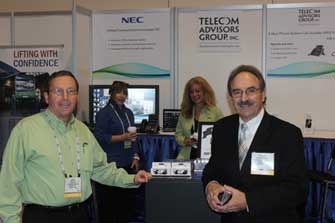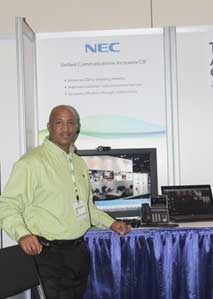 Many organizations find that they need to update their existing communications systems, but lack the Capital budget to do so, or they’re simply apprehensive to make an investment in technology which seems to be ever-changing. However, in our current business climate, the status quo when it comes to technology upgrades quickly leads to reduced productivity, poor customer service and increased cost. For this reason, many leading organizations have moved their technology upgrades from their Capital budget to their Operating budget by leveraging financing.
Many organizations find that they need to update their existing communications systems, but lack the Capital budget to do so, or they’re simply apprehensive to make an investment in technology which seems to be ever-changing. However, in our current business climate, the status quo when it comes to technology upgrades quickly leads to reduced productivity, poor customer service and increased cost. For this reason, many leading organizations have moved their technology upgrades from their Capital budget to their Operating budget by leveraging financing.
To replace or not to replace?
Let’s face it, advances in technology are designed to make us more productive and give us the ability to perform more efficiently while enhancing responses to our customer’s needs. That being said, if you’re not leveraging technology to provide better service, you may be at a disadvantage when compared to your competitors.
Technology is changing so rapidly that whatever you acquire today may be obsolete within five years. If you’re wrestling with the dilemma of whether or not upgrading seems worth it, you’re not alone. More and more businesses are reaping all the benefits of new technology while simultaneously hedging against technology obsolescence through a Fair Market Value lease. A Fair Market Value lease option allows your organization to obtain all of the productivity benefits and enhanced customer service capability delivered by today’s Unified Communications, Mobility & Collaboration tools while giving you the ability to retain your hard-earned cash and providing you with the least-cost option to deliver a solid ROI.
A good example of this is NEC Financial Services’ current offering of Fair Market Value leases with rates at or even below zero percent. For many organizations, these rates produce a monthly cost figure on a new solution which often falls well below what the organization is currently spending for maintenance alone. With these figures, finding the elusive ROI becomes easily achievable. Additionally, this financing structure provides all the benefits derived from the use of the new technology without having to worry about ownership and the risks associated with long-term investment in ever-changing technology.
You don’t have to spend money to make money!
If you think you have to expend large amounts of capital just to grow your business, think again. Financing opportunities like the one mentioned above lends other options. Are you wondering how this is possible? Take a look at the following example:
ABC Company has identified that upgrading their outdated PBX provides an opportunity for significant cost savings. But there’s a problem. With no funds left in this year’s Capital budget, their IT Department will pay more for their existing, inefficient infrastructure until funds are available. Not to mention the risks associated with operating an outdated system that exposes the business to equipment failure.
What now?
With the help of NEC Corporation of America, ABC Company performs a cost analysis and determines that by leveraging NEC Financial Services’ 0% Fair Market Value promotional lease, they’re able to obtain the technology they need now at a rate that falls below what they’re currently spending for maintenance alone! Moreover, the improved productivity and enhanced customer service experience they’re able to produce by implementing Unified Communications and Collaboration is helping them to retain and acquire more customers. This makes the new solution a revenue producer rather than a cost burden.
Don’t get stuck in a rut like ABC Company - leverage a technology financing partner who offers the most accommodating (and cost reducing) structure for you. With NEC Financial Services, it’s a win-win with 0% FMV offered for 48 or 60 months on select communications systems. You’ll want to take advantage of this offer quickly. The savings are great but they won’t last. The offer ends August 30, 2013. For additional details, click here.
For more information and to learn how you can take advantage of a 0% Fair Market Value Lease, ask your authorized NEC Associate, or click below. If you don’t have an Associate, you can find one here.









 When your employees need information right away, where do they turn first? Is it a phone call? Text message? Or perhaps a tablet or other personal device? Regardless of which device your employee chooses to utilize first, mobility and easy-access is the driving force behind Unified Communications (UC) and how your communications strategy can enhance workforce productivity. How much importance do you place on “anytime, anyplace” access when making decisions about your organization’s communications strategy?
When your employees need information right away, where do they turn first? Is it a phone call? Text message? Or perhaps a tablet or other personal device? Regardless of which device your employee chooses to utilize first, mobility and easy-access is the driving force behind Unified Communications (UC) and how your communications strategy can enhance workforce productivity. How much importance do you place on “anytime, anyplace” access when making decisions about your organization’s communications strategy? As a member of the Small-to-medium business (SMB) sector, you can benefit greatly from Unified Communications (UC), as it allows you to cost effectively utilize comprehensive solutions previously only affordable to large enterprises. Smaller staff and fewer finances don’t have to inhibit your communications capabilities and being a growing organization shouldn’t stop you from gaining a competitive edge. UC can help you do this while containing costs and simultaneously furthering your ability to execute and innovate.
As a member of the Small-to-medium business (SMB) sector, you can benefit greatly from Unified Communications (UC), as it allows you to cost effectively utilize comprehensive solutions previously only affordable to large enterprises. Smaller staff and fewer finances don’t have to inhibit your communications capabilities and being a growing organization shouldn’t stop you from gaining a competitive edge. UC can help you do this while containing costs and simultaneously furthering your ability to execute and innovate. 